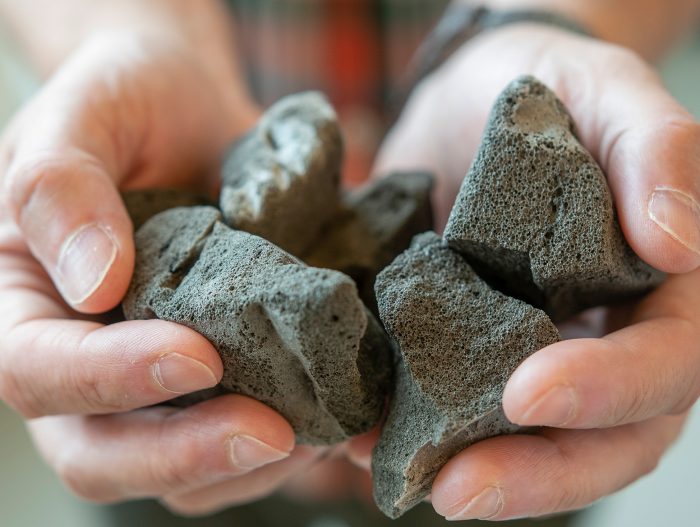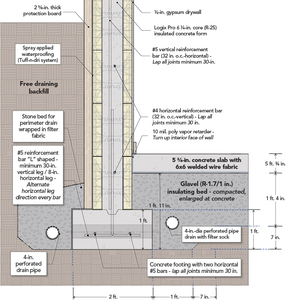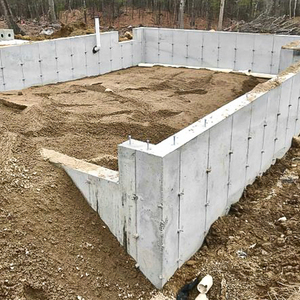A Vermont company is nearing the start of production of a building material made from recycled glass that can be used as both a drainage layer and sub-slab insulation.
Burlington-based Glavel announced it would open its new, 25,000-sq.-ft. production plant in nearby Essex and be ready to ship product by January.
On the production line, pulverized glass combined with glycerin, used as a foaming agent, travels on a conveyor through an oven at 1400°F–1600°F. The result is chunks of a gray, lightweight material weighing between 330 and 375 lb. per cubic yard, according to specs provided by the company.
Glavel will become one of two U.S. producers of a material that got its start in Europe. AeroAggregates also makes a foamed-glass product in Eddystone, Pa. Until now, Glavel has imported foamed glass from its German affiliate Glapor. That’s still the case, but CEO Rob Conboy says increases in container shipping charges have virtually priced European foamed glass out of the market.
In residential construction, foam glass can act as a drainage layer, a capillary break, and as thermal insulation below a concrete slab. It would replace rigid polystyrene foam insulation (XPS or EPS) as well as crushed stone that’s typically used for that purpose. When mechanically compacted, foamed glass has an R-value of about 1.7 per inch, according to the company.
AeroAggregates CEO Archie Filshill told GBA in 2019 that foamed glass is up to 90% lighter than stone aggregate, significantly reducing transportation costs. It can be used as a free-draining backfill around foundations and retaining walls and underneath patios, he said.
Conboy has previously said that foamed glass would be attractive to builders who are trying to steer clear of rigid foam because of environmental concerns, including the use of foaming agents with a high global warming potential.
New York–based 475 High Performance Building Supply lists Glavel on its website but the company says inquiries and orders are sent directly to Glavel. The retailer describes Glavel as a “load-bearing, thermal-insulating substrate” that can replace the aggregate layer under a concrete slab.
Conboy said by telephone that Glavel is working with logistics partners to make the product available anywhere in North America. Some, like 475, would be “lead generators” without actually stockpiling Glavel. But the company also is working on setting up a network of distributors around the country where builders could get Glavel on shorter notice. In New England, builders will be able to order directly from Glavel in Burlington.
A list of distributors would be ready by the first quarter of next year, Conboy said.
Glavel will be available in 2-1/2-cubic-yard bags and sell for $65 per cubic yard (not including freight charges). The bags are 6-ft. tall by 4-ft. square, so they will fit on a pallet for shipping.

Glavel is intended to replace both the insulation and crushed stone and gravel beneath a concrete slab, and when the cost of the rigid insulation (either XPS or EPS) plus the crushed stone is taken into consideration, Glavel should prove to be 10% to 15% less expensive within 300 miles of the Vermont plant, Conboy said.
The company says it will use between 15,000 and 18,000 tons of recycled glass per year, gathered in a 100- or 150-mi. radius of the Vermont plant. The output will be some 150,000 cubic yards of Glavel per year, Conboy said.
Electricity to run the production line, sourced from Green Mountain Power, will be “virtually carbon-free,” Conboy said, with the company aiming for 100% renewable power in the future.
Conboy said that AeroAggregates is the only other manufacturer of foamed glass in the country, but that he suspects interest will grown and other producers are likely in the future.
Scott Gibson is a contributing writer at Green Building Advisor and Fine Homebuilding magazine.
Weekly Newsletter
Get building science and energy efficiency advice, plus special offers, in your inbox.















20 Comments
Scott,
It may be worth mentioning that this is not the same material as the similarly named "foamglas" that is available from Owens Corning. It's not common in residential construction, but it might lead readers to investigate it as well.
https://www.foamglas.com/en-us/products
@Kyle, while it's not explicitly mentioned, there are links to Foamglas articles.
I hope both of these products take off. (The foam glass aggregate and the foamglas blocks.)
It's not clear from their website that they offer foamglas boards for residential at all. After they discontinued marketing it for residential a while back, people who wanted it were told it was not available.
I'm pleased to see that the cost looks pretty reasonable, and that the electricity will be low carbon. This is seeming like a really good option.
I wonder if it's an option for frost-protected shallow foundations.
Now we just need some low-carbon concrete to go with it.
Please excuse my ignorance, but that first picture ... is that just poured stem walls that are then filled in with Glavel? And then presumably a slab is poured on top?
Dackdotcom,
Good question. The walls are made of a foamed glass board called Glapor. (Here's a link: https://www.glavel.com/products_/glapor-boards/). The product can be ordered through Glavel and is produced in Germany.
Thanks Scott. This looks super cool. Are the boards attached to concrete? I did reach out to Tor at Glavel to see if there is a cross-section of this assembly. If I get anything I will post it here. The Glavel site is lacking any real good info.
Could this also be used for concrete aggregate? If so, would there be any concern that the foundation is no longer heavy enough to resist wind or earthquake loads?
I had the same thought, wondering if this could be used to make a super-lightweight concrete mix - or whether that idea is doomed by its low (116psi) compressive strength.
Most of the strength in concrete comes from the aggregate, so while you could make a concrete using foamed glass as part of or all of the aggregate, it would be too weak for typical construction situations. There are some other low-carbon concrete aggregates coming to the market, though.
Yes, but many concrete applications (flatwork, etc.) don't come close to using the full strength of the aggregate or overall concrete mix. My understanding is that the Glavel people are actively pursuing applications where lightweight and high-R aggregate would be appropriate.
Riveting video!
Looks like good stuff...
I am far from an expert in foundations, but Glavel + Glapor seems like a no-brainer. On the YT vid (https://www.youtube.com/watch?v=114Ov9Yi1gE) it looks like you just pour a perimeter foundation (with no form work), install the boards, then fill with Glavel. Pour the slab on top. Based on what I am seeing here, it seems like a regular guy could do most of this work.
If there are any readers who've done this assembly please post your experience.
Seems like a good idea. However, placing a few truck loads of recycled bottles under a garage slab probably uses less energy. I tried that over ten years ago. No cracks yet. Plus, the recycling truck did not have to leave town. Yes, an engineer will likely balk at the idea. I would say whole bottles are pretty strong.
Scott,
Any thoughts on using this material to insulate the exterior of an existing fieldstone basement wall? Does the material have to be compacted to achieve the R 1.7 (compacting would likely damage the existing wall)?
Fred Williams
Fred,
Have you thought about how you will deal with the above grade portion of the foundation if you went with foam glass below?
Malcom,
Thanks for your reply and question. I plan to wrap the house with mineral wool (https://www.greenbuildingadvisor.com/article/wrapping-an-older-house-with-rock-wool-insulation) and extend the mineral wool to meet the Glavel at grade. I would cover the mineral wool with clapboard siding and rain screen above the top of foundation, and protection board below. Would this plan work? I understand mineral wool is suitable for insulating basements on the exterior below grade, but not if the exterior surface is irregular as in the case of a fieldstone foundation.
Fred,
The company advertises R-1.7 performance after the material has been mechanically compacted, so this may not be ideal for your situation. If you want to pursue the idea, it might be worth checking with Glavel to see what the uncompacted R-value is.
Is the compaction not mostly done to create a stable layer and to prevent water penetration/pick up? If you do not compact you have the internal (thermal and "wind" washing") air flows and water might stay in - and you do not want to have soil creep into the gaps. But if you put some cover around the glavel - why not?
I am not sure about this..
Please explain what you mean about water penetration. Water would penetrate the Glavel ... where?
As for "soil creep," in the Glapor video they put down a geotextile layer to prevent that.
Log in or create an account to post a comment.
Sign up Log in